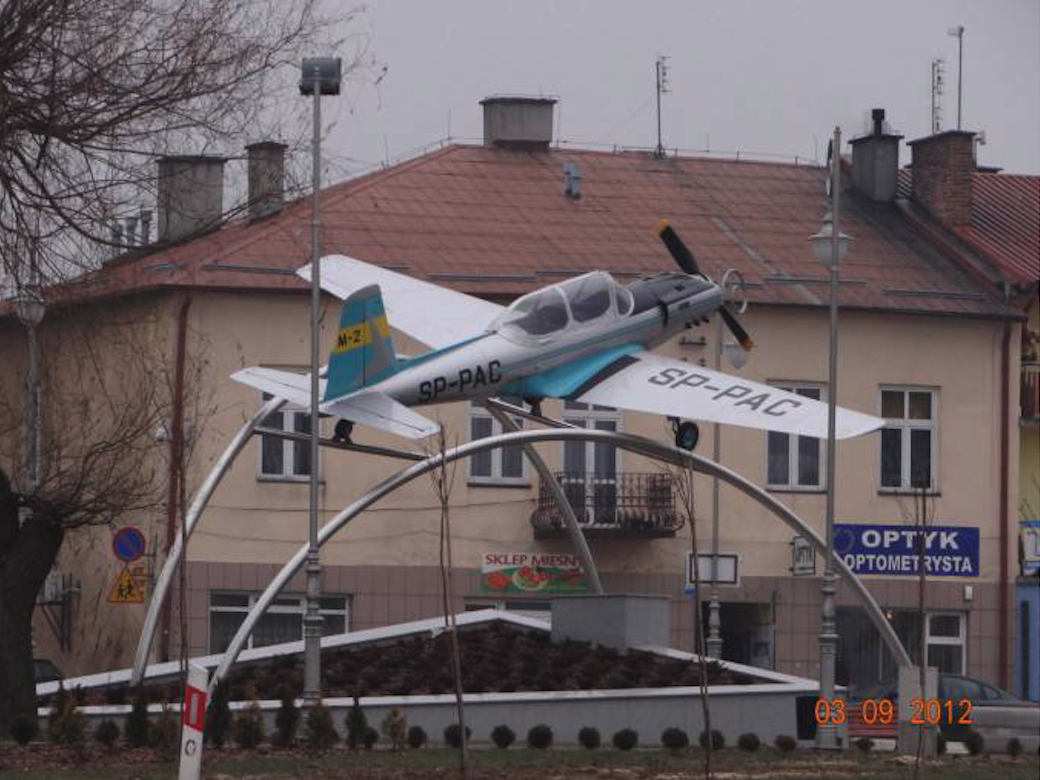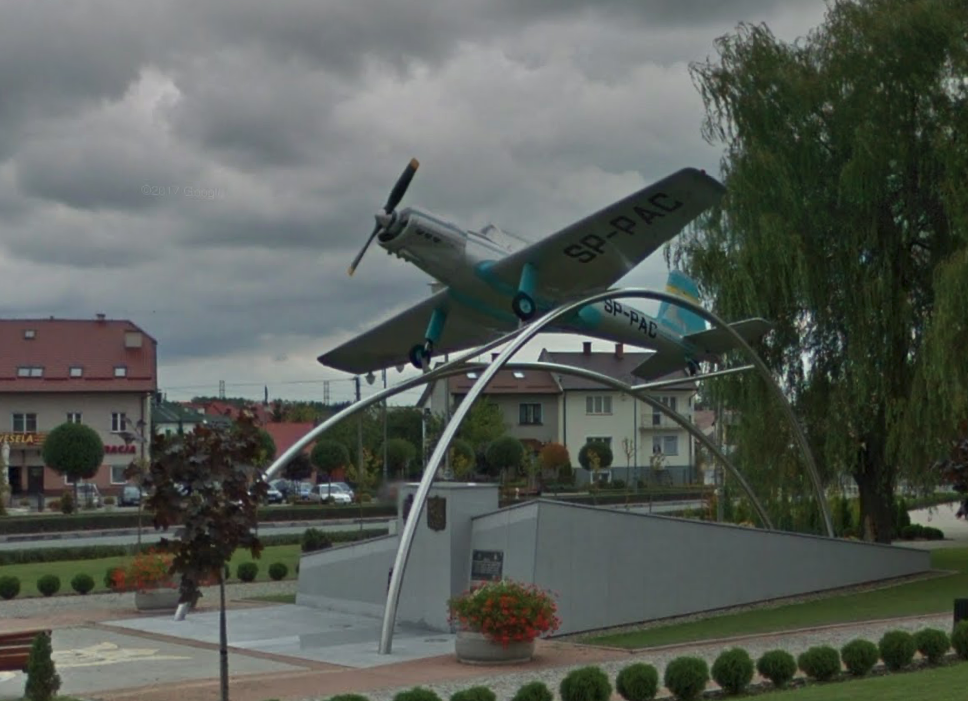157b Rozdział 1958-06-23
History PZL M-2

In 1957, the Aviation Structures Center No. 2 (OKL) was established at the WSK PZL Mielec plant, headed by Eng. Stanisław Jachyra. The team's first project was the M-1 single-seat aerobatic plane. The letter "M" stands for Mielec. Ultimately, the M-1 was not built. In 1957, OKL received an order for a two-seater training-training aircraft based on the M-1 program. The order was sent by the Aero Club of the Polish People's Republic, which was to buy about 50 planes.
The PZL M-2 aircraft was developed as an all-metal, low-wing, classic layout, with a cabin with tandem seats, and a fixed landing gear with a tail wheel. The drive was to use a flat piston engine with a power of about 150-180 HP.
Three airframes were built. One for endurance tests. Strength tests were carried out at the Endurance Department of the Institute of Aviation in Warsaw. At that time, engineer Tadeusz Chyliński was the head of the Department of Strength.
In 1958, the construction of the first prototype of the PZL M-2 aircraft, registration SP-PAC, was completed. The plane made its first flight on June 26, 1958. The test pilot was Tadeusz Gołębiewski. The second PZL M-2 aircraft, registration SP-PBA, made the first flight on September 13, 1958. Both aircraft underwent factory tests until November 18, 1958. Tests went well and minor bugs were fixed.
In September 1958, the PZL M-2 SP-PAC aircraft was presented at the aviation exhibition in Warsaw. In 1959, the PZL M-2 SP-PBA aircraft was presented at the exhibition in Wrocław. At that time, it was already known that the PZL M-2 plane would not be mass-produced. Fortunately, the PZL M-4 Tarpan was already tested, which was to be delivered to the Aero Clubs of the Polish People's Republic instead of the PZL M-2 planes.
In the spring of 1960, the PLZ M-2 aircraft underwent final state tests at the Institute of Aviation. The tests showed good flight properties and aircraft performance. Both prototypes had the Praga M-208B "DorisB" engines that did not have inverted-flight-capable carburetors, so the plane had limitations in acrobatics. Also, at a speed of over 220 km / h, the engine caused vibrations that were transmitted to the entire airframe. That is why the Polish WN-6 engine was considered.
As the Aero Club of the Polish People's Republic ordered the PZL M-4 Tarpan plane, and there were no other buyers to buy PZL M-2 planes, the program was closed.
Both PZL M-2 planes flew in Aeroklub Mielecki until 1972. Then the PZL M-2 SP-PBA plane went to Radomyśl Wielki and stands there as a monument until now (2020). The second PZL M-2 SP-PAC plane, after a few changes of owners, found its way to the warehouse of the Polish Aviation Museum in Krakow.
Written by Karol Placha Hetman
157b Section 1958-06-23
Construction PZL M-2

The wing with a trapezoidal contour. The wing is of a metal structure, two-spar, with a small number of ribs, semi-shell, covered with a duralumin sheet. The front caisson forms an integral fuel tank in the part by the fuselage. The cover of the caisson within the tank is covered with laminate. Differential, slotted ailerons, coupled with flaps, metal structure, single-spar, covered with cloth. Electrically actuated crocodile flaps. Raise the wing positive 3 degrees. Profile at the NACA 23015 fuselage, NACA 23012 at the wing tip. Relative wing thickness is 10%. 120 liter fuel tanks mounted in the wings.
The fuselage of a semi-shell aircraft with a small number of frames and stringers. The metal covering of the aircraft fuselage is also a durability element. The front part houses the engine, the bed of which consists of two metal beams. The beams run all the way past the crew compartment. A fireproof partition is installed between the engine and the cabin. The rear part of the fuselage is conical, semi-shell. Sheet metal cover, stiffened with ribs and stringers. On the spine there is an aerodynamic steering wheel, which transforms into a vertical tail. Two-person crew cab in tandem configuration. The cabin is completely covered. The canopy can be moved to the rear.
The tail of the plane has a classic, free-bearing, trapezoidal layout. Two-spar ballasts, semi-shell structure, covered with sheet metal, stiffened with stringers. Vertical stabilizer permanently attached to the fuselage. Non-split horizontal stabilizer. Single spar rudders, sheet metal covered. One-piece elevator, not divided. Cloth covered rudders.
Tricycle with tail wheel, not retained in flight. Main landing gear legs are surrounded by fairings. A reflector is mounted at the base of the left leg. Main chassis with a wheel track of 2.6 m, equipped with oil-air shock absorbers. Wheels with low-pressure tires, dimensions 465 x 165, equipped with hydraulic brakes. Self-aligning tail wheel with oil-air damper.
Aircraft equipment: Ultra-shortwave radio, on-board radio.
Praga M-208B "Doris B" engine, six-cylinder, flat, air-cooled, with a take-off power of 220 HP, and a nominal power of 180 HP. Electric motor starting. Wooden, fixed, two-blade propeller. The PZL M-2 SP-PAC prototype had a BJL-5 type propeller with a diameter of 2.35 m, and the PZL M-2 SP-PBA aircraft had a BJL-6 type propeller with a diameter of 2.31 m.
Data T-T PZL M-2:
Span 9.50 m. Length 7.62 m. Height 3.02 m. Bearing area 13.62 m2. Curb weight 788 kg. Payload 300 kg. Gross weight is 1,067 kg. Top speed 256 km / h. Cruising speed 206 km / h. Landing speed 105 km / h. Rate of climb 6.3 m / s. Service ceiling 5,475 m. Range 600 km. Fuel tank 120 liters. Fuel consumption minimum 46 l / h. 160 m run to start. 180 m run to stop.
Written by Karol Placha Hetman
157b Section 1958-06-23
Tally PZL M-2
Only two planes were built. Both PZL M-2 planes flew in Aeroklub Mielecki until 1972. Then the PZL M-2 SP-PBA plane went to Radomyśl Wielki and stands there as a monument until now (2020). The second PZL M-2 SP-PAC plane, after a few changes of owners, found its way to the warehouse of the Polish Aviation Museum in Krakow.
Written by Karol Placha Hetman
